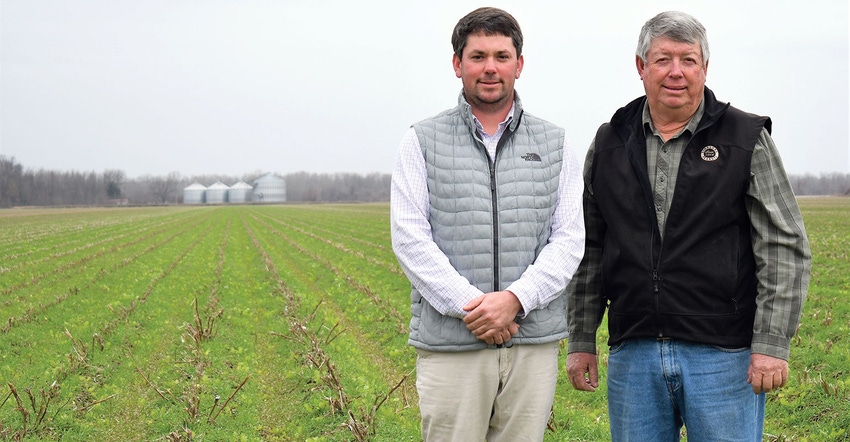
Milton Parrish and his son, Drew, are counting on technology to simplify farm practices and to increase profitability of their Triple D Planting Company.
The Holmes County, Miss., family farm includes cotton, corn, soybeans, and peanuts.
Milton's sons, Drew and Daniel, makes up the other legs of Triple D Planting Company.
"Daniel was in the farming operation, but now works for Black Gold, a sweet potato operation over in Louisiana," Milton said.
Irrigation technology
He said technology, including enhancements to irrigation, improve farm efficiency.
The farm is now about 80% irrigated.
"We're both pivot and furrow irrigated," Drew said. "We have 26 wells, and 14 are center pivot operated.
"Also, we've done some land-forming in the past three years to get our number to about 80% irrigated now. Our goal is to get as much converted to irrigated land as we can."
Their pivots have flow meters and drop nozzles. They also use surge valves on their sandy soil which is furrow irrigated.
"We have meters on some of our pivots," Milton said, "as well as soil moisture probes that help us time our irrigation to be more efficient."
"We can access the irrigation systems from our phones, and it gives us a timeline of when the next irrigation may be, according to the forecast. We don't always listen exactly to what it says, but we definitely take it into consideration to make a sound decision," Drew said.
Controlling the pivots from a phone also comes in handy since their farmland is scattered from Tchula to Cruger 15 miles north.
"We have 14 pivots scattered. Being able to monitor those during peak season, when they are all running at once, helps to save driving time," Drew said.
Herbicide technology
Technology plays a crucial role in weed control, as well. They use dicamba in cotton and soybeans, and Halex plus atrazine in corn.
"On peanuts and soybeans, we have been using a product called Zidua that has been working well as our residual herbicide for our crops," Drew said.
They also use Boundary as a pre-emerge on soybeans and come back with dicamba and Zidua as a postemerge.
"We add about 250 units of nitrogen to our corn, and we split that up into three different applications," Drew said. "I think splitting our nitrogen into three applications has really benefited the plant to get the fertilizer it needs throughout the growing season.
"We use a Mud Master for specialty type situations where a big sprayer would be too heavy and make ruts. We also use the Mud Master in fields that are too small to be efficient with a large applicator. Plus, it has a wick bar for escaped pigweeds, one of our main weeds of concern. Luckily, overlapping residual herbicides combined with dicamba has helped us to manage pigweed well.
Rotation
"We farm 4,800 acres of cotton, corn, soybeans, and peanuts," Drew said. "We typically plant enough corn to fill our bin capacity.
They are going to use variable-rate seeding with corn.
"We also converted our 1720 JD Planters to Precision Planting vDrive this winter, and we added Precision Planting's DeltaForce and SmartFirmer to help plant more precisely," he said.
Triple D Planting Company follows a three-year peanut rotation on their sandy soil, Morganfield and Adler type dirt.
"We switch between corn and cotton for two years, and then we plant peanuts the third year to reduce disease pressure," Milton said.
On the rest of their acres, they rotate cotton, corn, and soybeans, depending on the market as to how many acres of each they grow.
"We planted a cover crop this year for the first time, about 1,000 acres of cereal rye and radishes to improve soil health and reduce land erosion. We're hoping that works well in our crop mix. We plan on burning that down in the spring, and then planting into that cover crop mix," Drew said.
"We have two peanut combines, and they can handle up to 700 acres, so we hardly ever go over 700 to 750 acres of peanuts. Last year, we had 600," Milton said.
Old school
They are depending, to some extent, on effective old school technology for an increasingly pernicious pest — wild hogs.
"They are a big problem in the corn and peanuts, especially in fields close to the wildlife refuge," Milton said. "The refuge serves as a breeding ground for the hogs, and it's impossible to control the population. We hire people to help get rid of them because you can't stay up and work all day and try to keep them out at night. We also put up an electric fence along the property line which has been a big help."
Planning ahead
Milton and Drew are spending time this winter to plan for the coming growing season.
"We are going to reduce our cotton acres unless the prices change quickly," Milton said. "We already have our rotation set for peanuts, but our corn acres will go up this year, and we may have a little more soybean. We don't like to raise much more corn than we can store, but if the price goes up tremendously, we might plant more."
Right now, their plan is to have about 2,000 acres of corn, 1,100 acres of soybeans, 700 acres of cotton, and 750 acres of peanuts.
"Nothing is written in stone, though," Milton said.
About the Author(s)
You May Also Like




